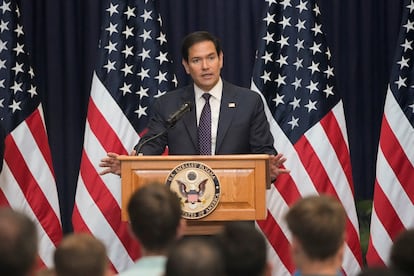Panama will not renew the agreement of understanding with China after meeting with Marco Rubio

Panama will not renew the agreement of understanding he signed with China in 2017 in the framework of the Silk Route, a strategic plan of geopolitical and economic ramifications to which Beijing assigns a vital importance for its economy. The decision was announced this Sunday by the government of José Raúl Mulino after a meeting in Panama City with the Secretary of State of the United States, Marco Rubio. The head of Donald Trump’s diplomacy had warned Mulino that Chinese influence on the Panama Canal was “unacceptable” for Washington. And it went further: if the Central American country does not make “immediate changes” in this regard, “the United States will take the necessary measures to protect their rights,” said State Department spokesman Tammy Bruce. In a press conference after the meeting, Mulino said that “there is no real threat (by the United States) to recover the channel or the use of force.” The agreement between Panama and China must be renewed in 2026.
Mulino reviewed the conversation held with Rubio without mentioning the threat of Washington or his decision not to renew the agreement with China. “It was a very quiet and respectful encounter,” he said. This Sunday was the first stop of Rubio’s official visit to Central America and the Caribbean. Mulino, with a friendly tone, took the opportunity to send a message to Trump: “We want to work with the United States as we have always done.”
Custodied for his official security, Rubio got off a truck, walked under the soft summer sun and greeted the chancellor, Javiel Martínez-Facha, who was waiting for him on the portal of the Palace of Las Garzas, headquarters of the Panamanian Government. He was alone for more than an hour with the Mulino President, and then joined an extended meeting with the teams of both governments, for two more hours. “The channel is not negotiated,” Mulino repeated after the meeting, what did he negotiate? The control of the migratory passage through the Darien, intelligence information on money laundering and organized crime, investments and, probably, ports on both sides of the canal.
To get the channel out of the fight, the Panamanian government invested more than two million dollars in Republican wolves – one of them so Trumpist that he even asked to invade Panama, as George Hw Bush did on December 20, 1989 – and aligned his cabinet With its strategy of not climbing the conflict. The president did not want to, “she wants,” fight with the United States. He had given clear signs that he preferred to deliver anything, except the only step between the Atlantic and Pacific Oceans.
On Sunday, there was relief among Panamanian officials present at the meeting – among them, the Ministers of Security, Economics and Foreign Relations, in addition to advisors such as the former administrator of the Panama Canal Authority (ACP), Alberto Alemán Zubieta. While they exchanged with Rubio and their delegation, other Panamanians protested a few blocks from the official office.
In a place in front of the National Assembly, social and workers organizations demonstrated against Rubio. Waving flags and guarded by the police, they shouted slogans against “the invading country” and the “corrupt oligarchy” “that steals the people” from “their traditional political parties.” “It is the town, a handful of them, who holds national dignity,” said a speaker.

So far, Trump has not commented on the results of the negotiations with Panama. In addition to that country, in the last two weeks the president has generated conflicts with three of the five countries that most export to the United States: Mexico, Canada and China, whom on Saturday imposed rates of 25% and 10%. At least ten times he pointed out during the last weeks against Panama, denouncing China’s alleged influence on the channel, something that the Central American country denies.
Anyway, Panama will give up some control in the border territory with Colombia, in the province of Darién, where a landing floor will possibly be built to deepen the deportation policy of migrants started last July, when Mulino assumed. “We remained to explore the possibility of expanding the memorandum we signed on July 1 to be able to articulate more,” said the president. Also, according to a government source, they would be willing to open the bolt that protects the classified information on money laundering and organized crime.
Mulino left the door open to review the concession of the two ports on the edge of the channel to a company based in Hong Kong. “At the moment, these concessions are audited by the Panama government and we have to wait for these audits to end, to get our own conclusions and act accordingly,” said Mulino. It was an announced assignment, taking into account that the government considered that it had no alternative. “They are the ones who handle the buttons,” said a member of the official Panamanian delegation in reference to the United States.
After seeing the president, Rubio went to meet the employees of the Embassy, located in the building that the United States maintains in the old channel area. He also planned to visit the facilities of the North American Capital company AES in the province of Colón, where 60% of the channel operations are. In the afternoon, he planned to close Miraflores locks, built by the United States in 1903. The Rubio tour will continue to El Salvador, Costa Rica, Guatemala and the Dominican Republic.
(Tagstotranslate) America
Source link





